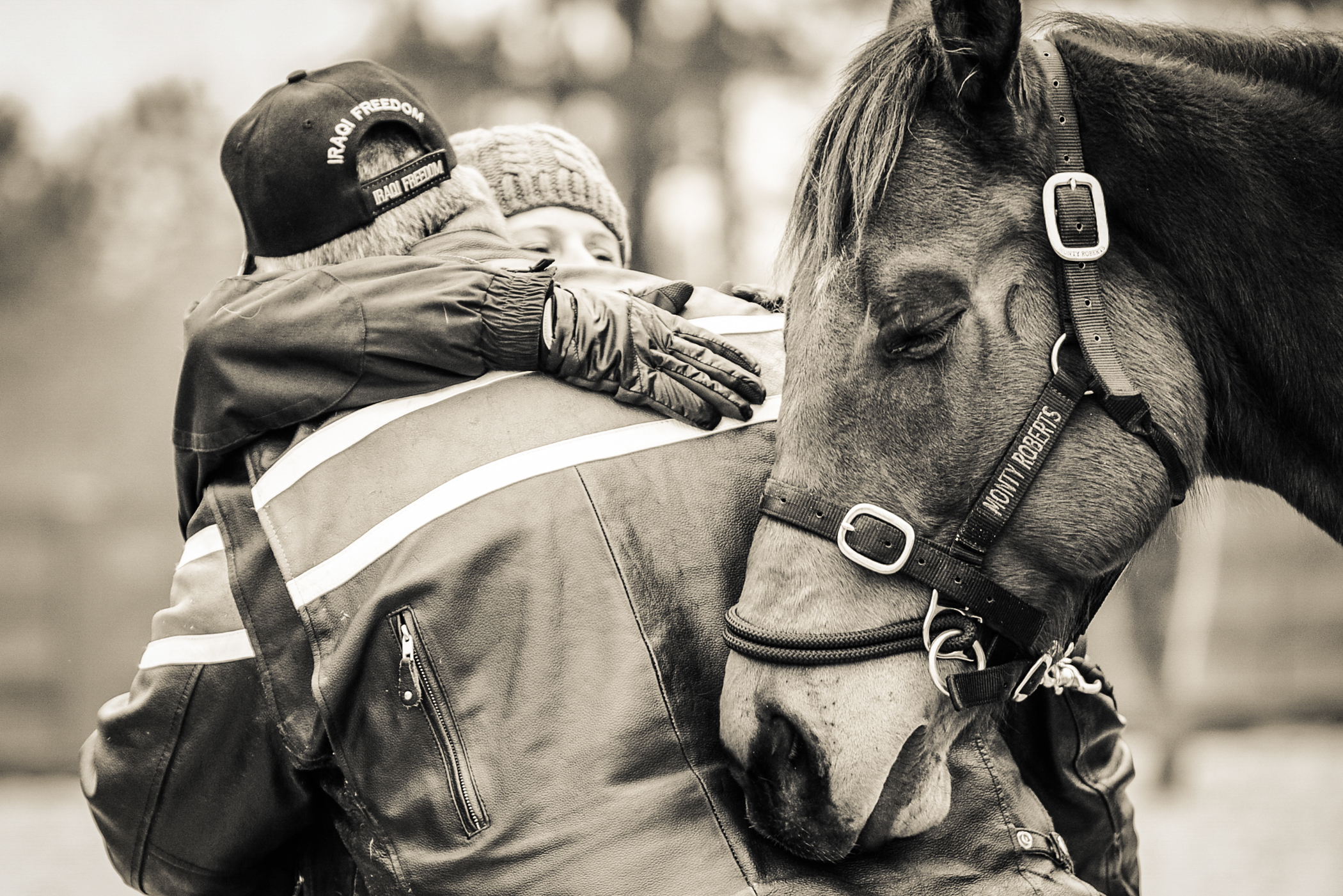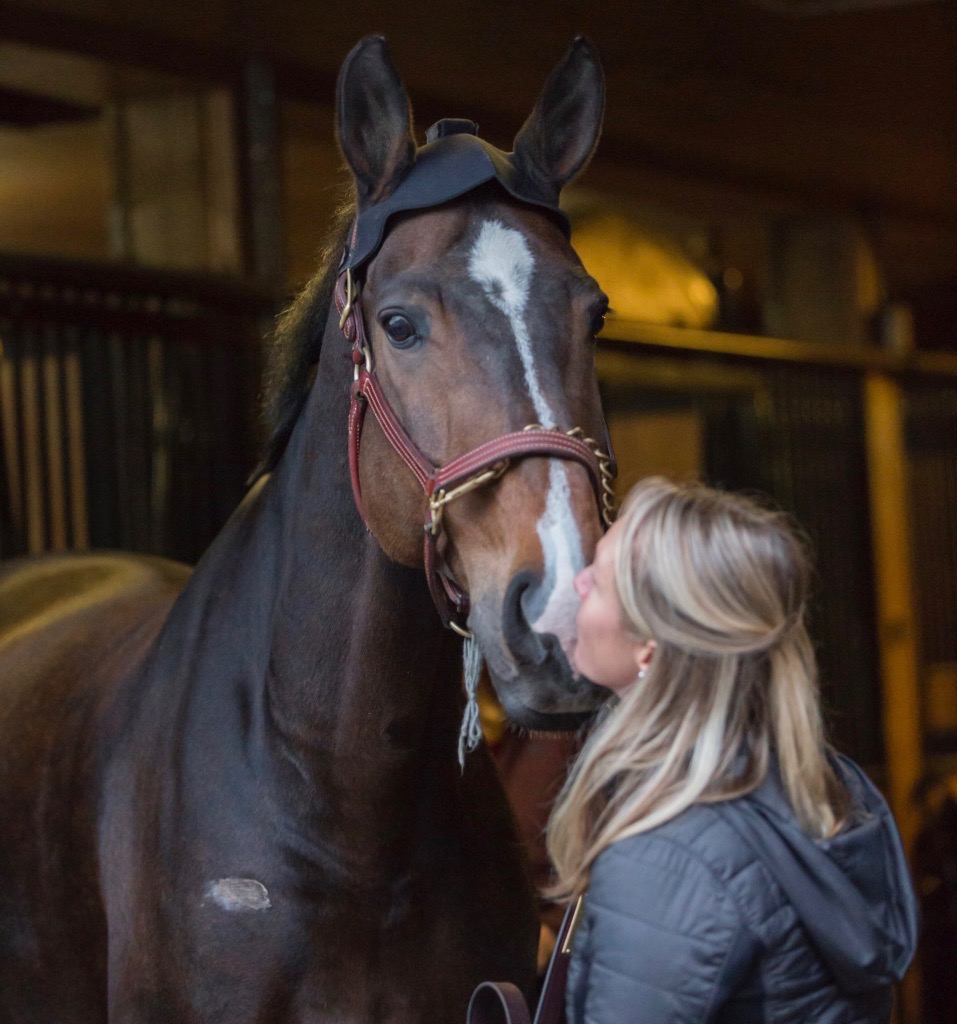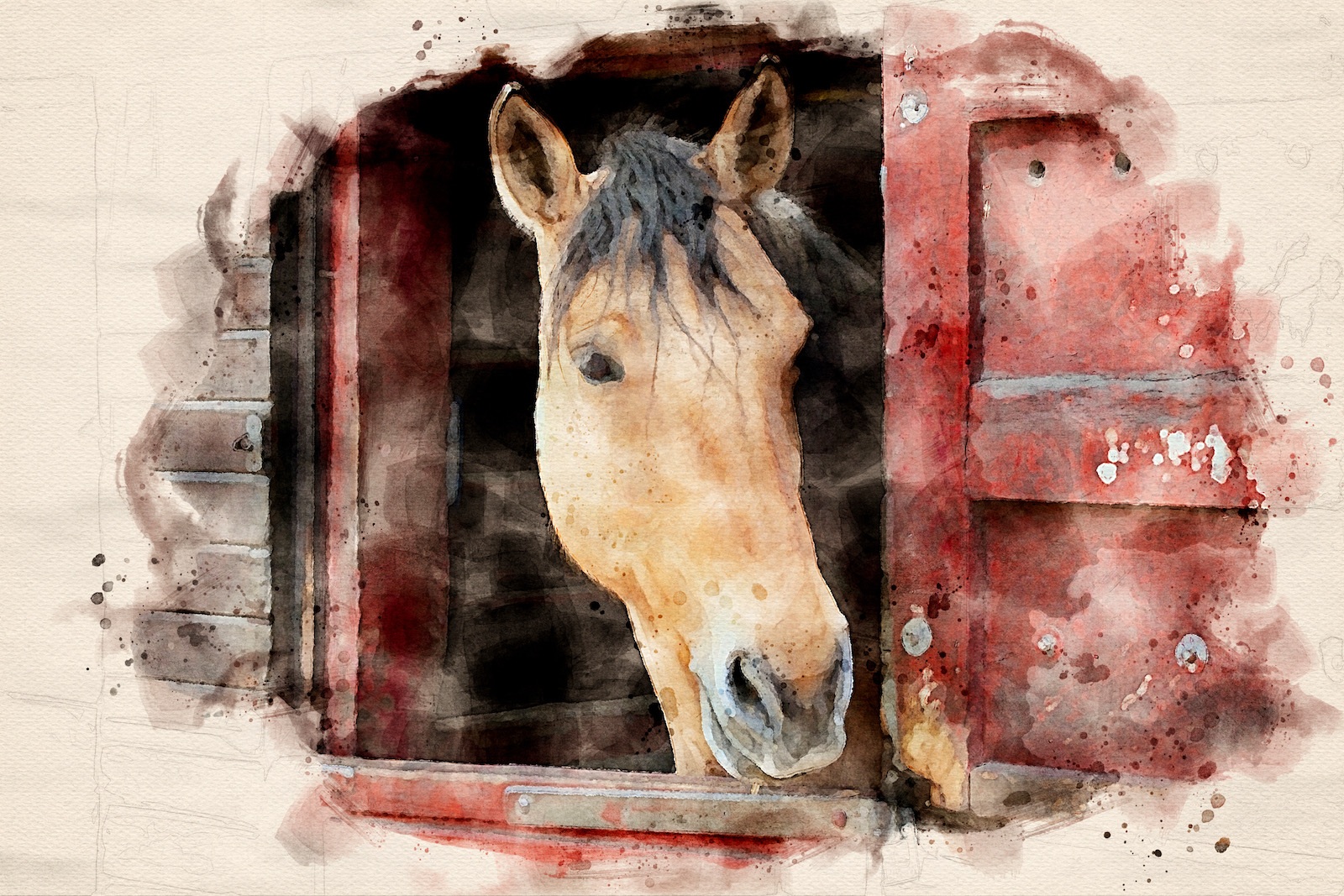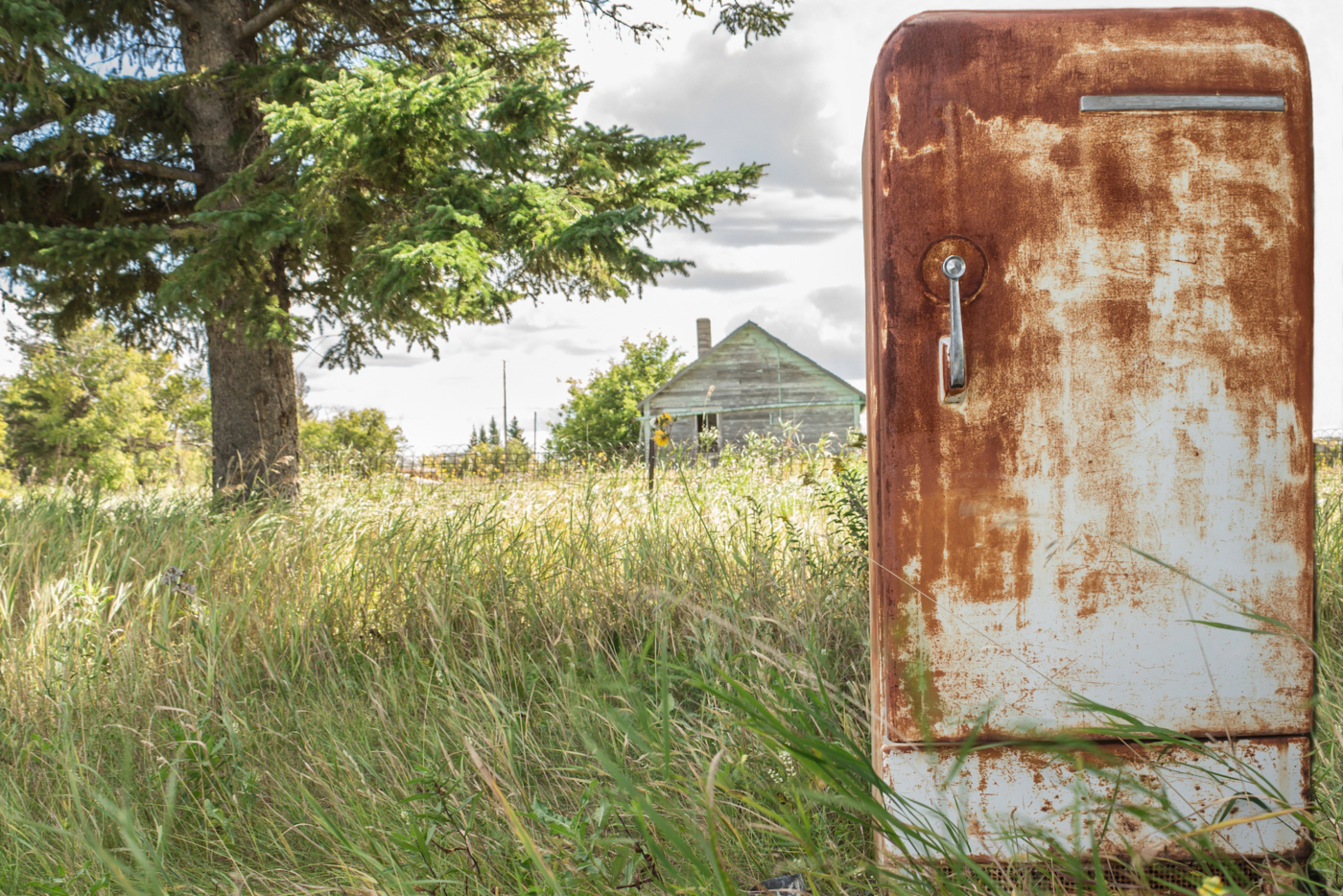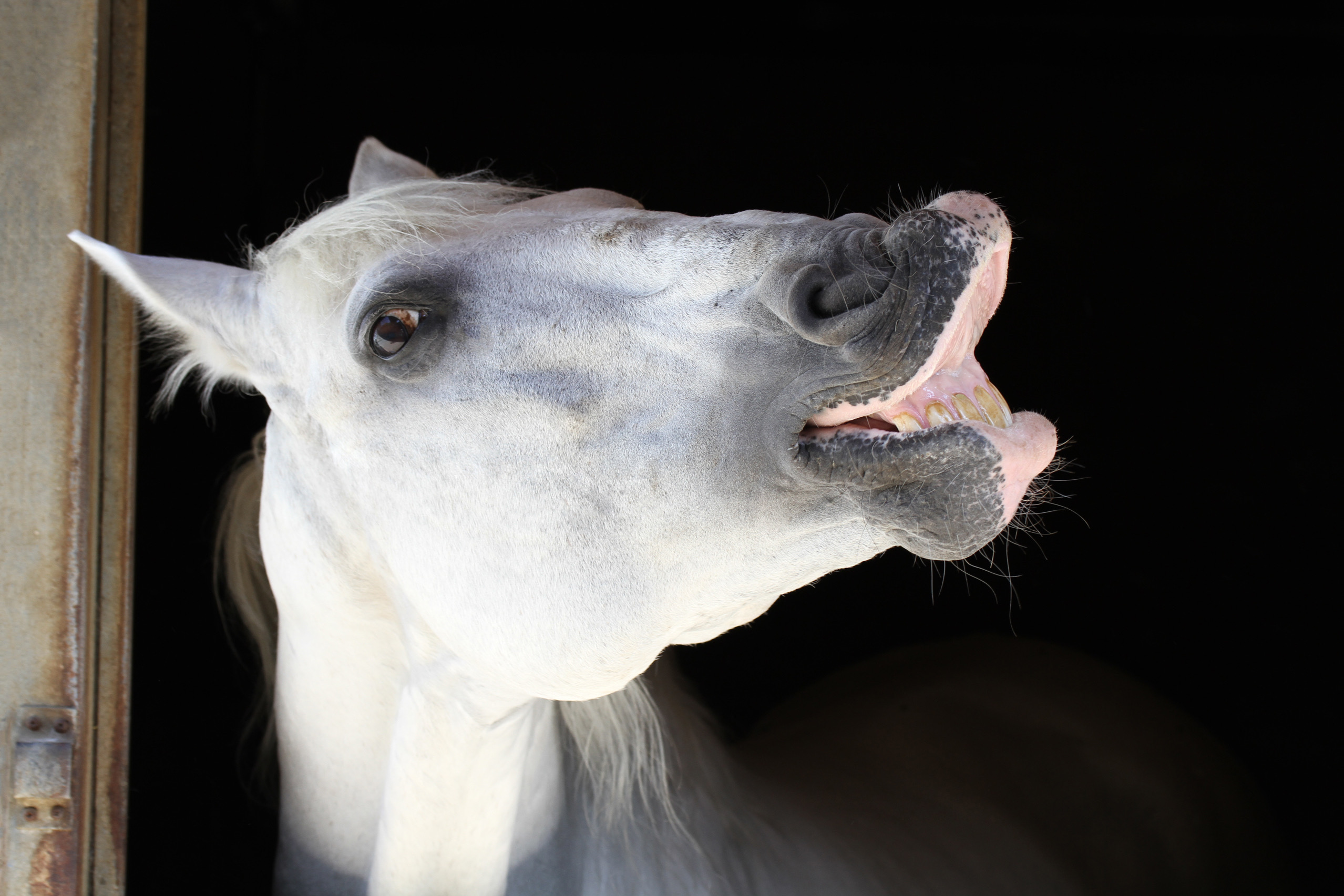Outside Rein was born out of a desire to share experiences, ideas, and stories with equestrian enthusiasts, and it has opened many doors for us. Since the initial launch, our small, personal equestrian communities have become vast, and we are fortunate to meet interesting, inspiring people every day. Self-described horse facilitator, TED talker, problem-horse fixer, equine advocate, author, and all-around do-gooder Julie Robins is no exception. We recently crossed paths with Julie, and after only a few minutes of horse-chat we knew we had to share her story.
Julie is the founder of Aiken Horsemanship Academy in Aiken, South Carolina, where she teaches passionate equestrians about what drives horses, and how to connect with them outside of the saddle. Additionally, Julie is an Equine Connection Coach at Saratoga War Horse, a non-profit organization that provides healing, equine-assisted experiences to veterans with Post-Traumatic Stress (PTS) by introducing them to off-the-track thoroughbreds.
At OR, we completely subscribe to the notion that horses promote healing from the inside, and as equestrians with veterans in our families and inner circles, organizations such as Saratoga War Horse are near and dear to our hearts. This week, we had an incredibly enlightening chat with Julie about her twenty-five years of experience in the equine industry, and how she has used her knowledge to help make the world a better, safer place for over 500 brave individuals who deserve it most.
Additionally, we would like to extend our gratitude to photographer Shelly Schmidt for providing the following images, and for offering to donate a print from her recent exhibit, “Silent Witness,” to help spread the word about equine-assisted experiences for veterans. Sign up for our weekly email to be automatically entered to win.
Scroll down for more details.
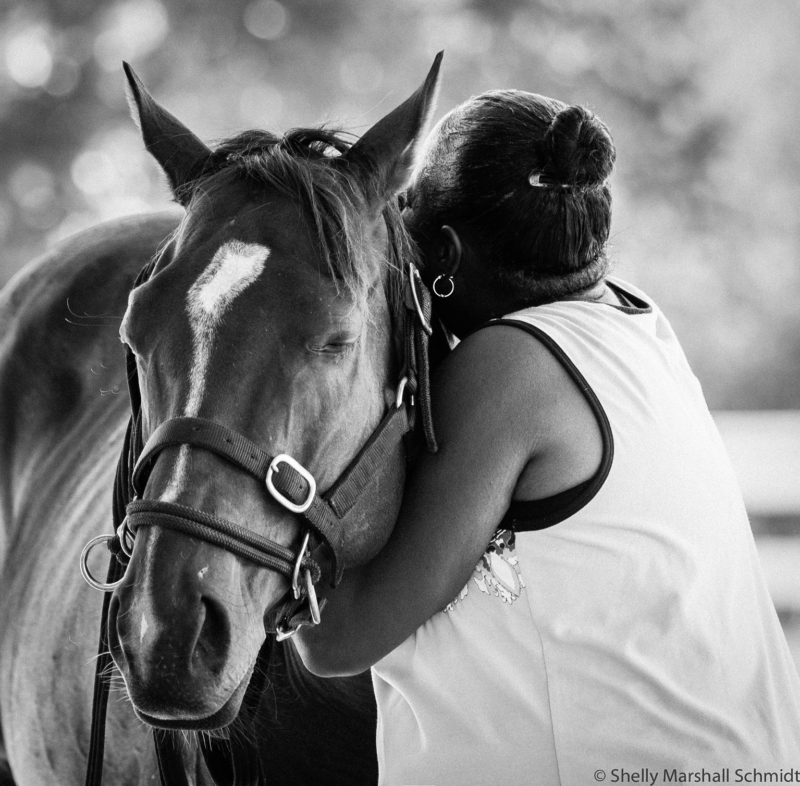
How did you get involved with horses, and how did you turn that passion into your business?
I learned horses and horsemanship as an adult. I grew up as a kid on a beach; surfing, sailing swimming, and wishing I had a horse. That just didn’t happen until I got to college, when I had a good friend who was on the hunter circuit, and she let me ride her horse. We went out to figure out how to play polo because she had a crush on a polo player, and I ended up in a really bad accident. That sort of changed things and added fear, but it didn’t suppress my desire to want to ride.
At that time, I was at the University of Florida working on my master’s degree in Architecture and Urban Planning, because my father had told me that if I wanted to do the horse thing I would need a lot of money, and that I had better get a really good technical degree. Very good advice from my dad! Eventually, I decided to volunteer at a therapeutic riding program, because I figured that if the horses there were safe enough for children and adults with disabilities, then maybe they were safe enough for me. That’s where I started to build my confidence back up, and I realized that just because somebody told me what to do with a horse, didn’t mean it was right. Instead of blindly accepting what people taught me, I began to question it (usually not out loud, though, because most horse trainers don’t like you to ask questions!). I bought my first horse, and that’s when things really started to align for me.
You refer to yourself as a horse facilitator. How do you describe that to people?
I do struggle to explain what I do. One of the challenges I face is how to express this style of working with horses, and helping equestrians understand the benefits without sounding like a woowoo psychic flake! I’m very pragmatic and practical, and safety always comes first. My background is in therapeutic riding as well as natural horsemanship. So what I do merges the two. I started my time with horses volunteering with a therapeutic riding program and learning to ride there. In the last 20 years, my focus has been on learning about training horses using horsemanship techniques. I call what I do helpful horsemanship, trying to help the horse with people problems and the people with horse problems.
This is also the order in which it evolved for me. In college, I did anything to be with horses. I enjoyed volunteering at a therapeutic riding center as well as taking riding lessons there. When I got married, I had the time and resources to study horsemanship and help a horse of my own be less bolty and pushy, and to become more ridable. Once in Aiken, I hung out my little shingle for natural horsemanship and got very lucky to have Adam Snow as my first client. Adam has now been inducted into the Museum of Polo and Hall of Fame, and it was very cool to work with a high-level equestrian professional who took my tips and techniques to heart, then witnessed a miraculous change in his horse. None of his problems were life threatening or dangerous, but they tweaked his game a bit. He knew that if he could get his horses to do better, he could play better and win. And he did! So that was my first step into this business in 2005 – “Let me fix your problem horse.” I very quickly became pretty well known for fixing almost any problem.
Somewhere along the way, I shifted away from working with problem horses to working with people who wanted to learn before their horse became a big problem. I began trying to reach people who didn’t really have a massive issue with their horse, but wanted to learn more, and to do better. They wanted inspiration and deeper connections, and they were finding that when they just poured out their souls to their horses with carrots and apples and lots of human-style affection, it wasn’t enhancing their relationships. At times it was even making their relationships less productive. That’s when I started teaching tools out of what I now call my “aha toolbox.” The tools are just relationship building skills, and I use the term “relationship building” because evidence shows that the skills extend beyond horses into all types of relationships in life. Horses and life are all the same to me – it all blurs.
Do people try to liken you to a horse whisperer?
Sometimes, and that used to make my skin crawl. It just annoyed me, as did “horse trainer.” I’ve been called that forever, but I’m not really training horses; I’m just bringing out the qualities that they already have.
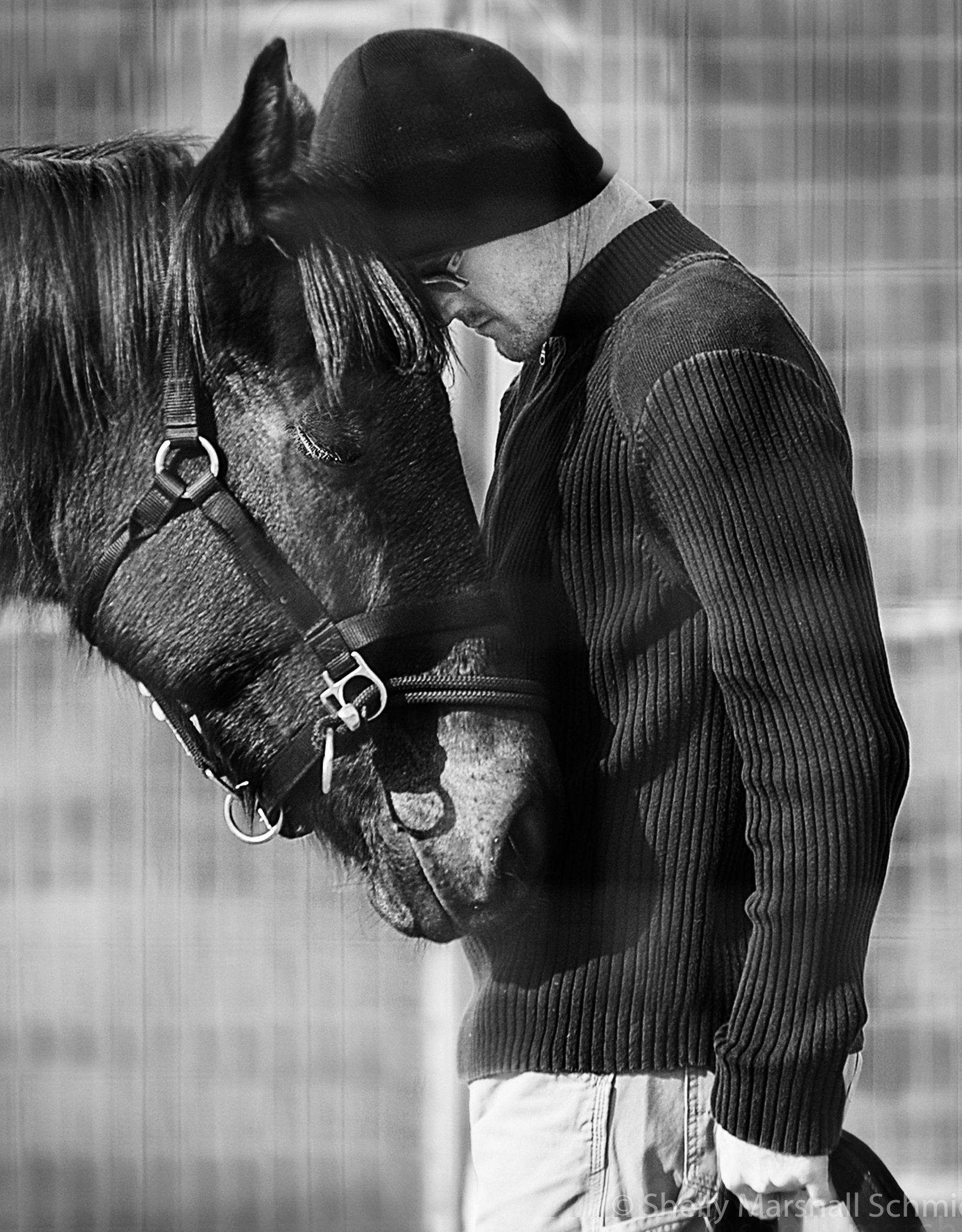
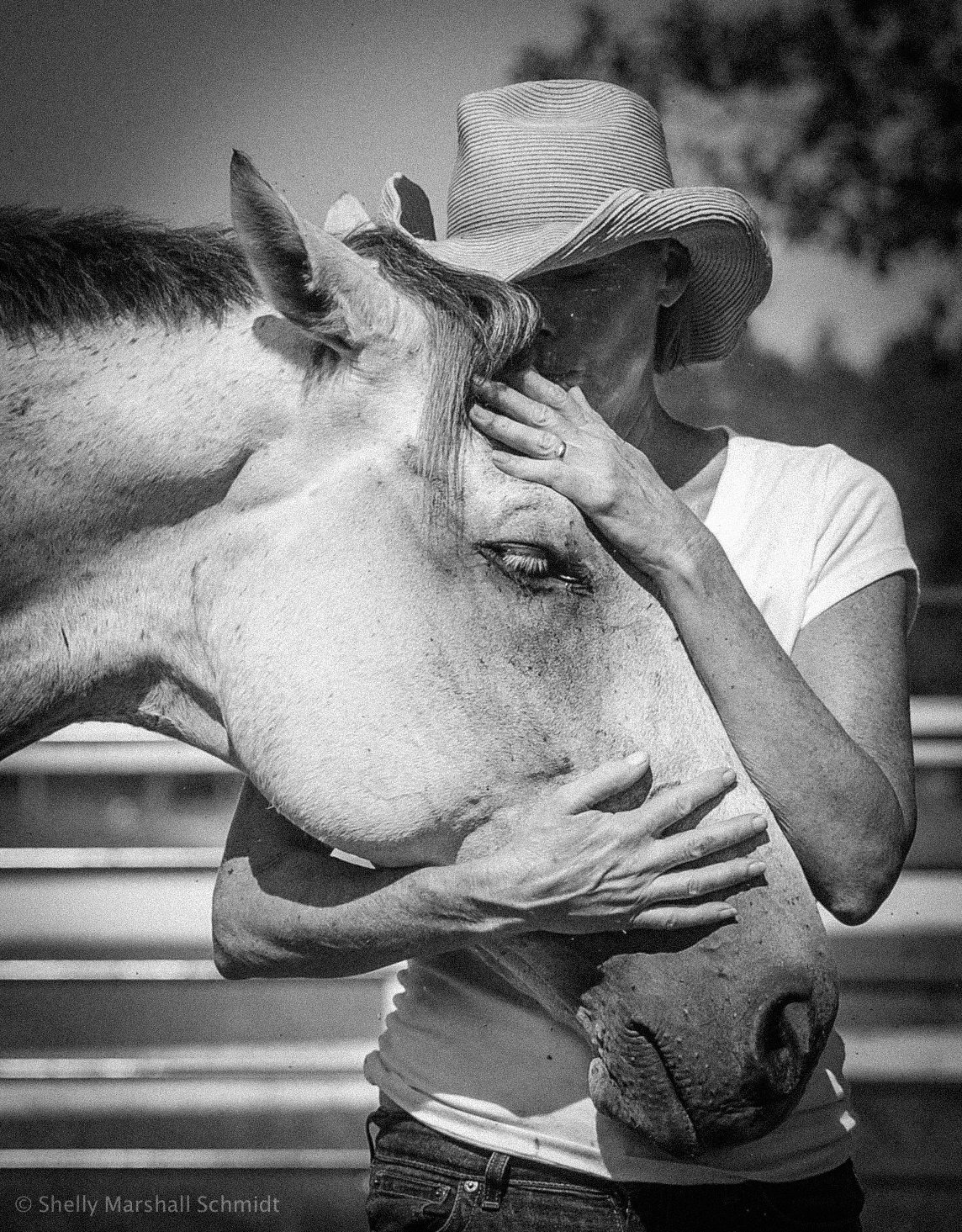
How do you see your business evolving over the next 5-10 years?
That’s a great question. I ask myself that all the time. Right now, I’m dialing back from taking in the serious problem horses and starting the green horses. I’m doing that very selectively now for horses in particular that I want to videotape. I’m getting into the legacy phase of my career, where I want to leave this information behind in a tangible form; preferably video, the written word, and tools like that. I’ve also had a handful of mentees and interns over the years that have gone on to create their own businesses, which I’m really proud of. I never wanted to go down the route of certifying people, as I feel like the work is so personal that it’s got to become your own.
I love doing the work of life enhancement through the way of the horse, and as long as I have a breath in me I’m going to be out there being the horse’s advocate. I believe that most horses have good intentions, and we just have to learn how to meet them there. I also believe that if people knew better, they would do better. People aren’t mistreating horses on purpose, but there is such a lack of education in regards to how we can help the horse as a horse, and natural horsemanship has done a lot for it, but even that has some negative connotations. So now I’d like to focus on how I can inspire people to really help out their horses, and I’m trying to figure out how to do it while reaching more than one person at a time through my website, The Horsemanship Academy.
How did you transition into the Saratoga War Horse (SWH) world? Did you bring the program to Aiken?
I can’t take credit for bringing Saratoga War Horse here. A good friend of mine, Anne Campbell, actually brought the idea of the program to us about six years ago. She was up in Saratoga and met a woman whose husband was a veteran. He had been having a very difficult time, and he was on the phone with suicide prevention at the Veterans Affairs Department. He called her to tell her he was not going to make it, that they’d put him on hold again and he was going to kill himself. She tried to counsel him and told him she was on her way home, but by the time she got there he had taken his own life. Of course, she was incredibly traumatized by that. She had heard about the SWH program for veterans to prevent suicide and help with post traumatic stress. She reached out to them, and they took her in and put her through the program. It radically changed her life by giving her a sense of peace and hope, and when Anne heard this woman’s story she knew she needed to bring the program to Aiken. The founder in Saratoga agreed to expand, and Aiken Equine Rescue offered up their facility for free. They had been bringing in thoroughbreds off the track from West Virginia, so it all sort of fell into place. When Anne reached out to me and said she had the program and the place, she said I was the one with the skillset to make it happen. I actually declined at first, which Anne still loves to tell people! I had a history at STAR Therapeutic Riding (now called Great Oak), and I had been the executive director of another therapeutic riding program. Based on my previous experience, I knew that I couldn’t take it all on, plus I still had my company. Anne assured me that it would be a team effort, so I came on board.
We’ve been going strong for 5 years, and I’ve personally worked with over 500 veterans. To date, SWH has worked with over 2000 veterans. We have a third center that has opened in Baltimore, Maryland. Baltimore County put in a publicly owned facility as part of their agricultural center, and they run several programs through there. They primarily wanted SWH to come in so they could add an offshoot program for first responders, and that’s something that I’d love to see happen in Aiken. It would be wonderful to set up a program that would help first responders, because suicide is a true problem for them. They see trauma every day, and while they do debriefs and receive grief counseling, they keep going back into it every day. Our community has lost several medics to suicide in the past couple of years.
Tell us a bit about how a veteran can become involved in the program.
SWH has classes twice a month for ten months out of the year. It is a self-referral program, meaning that the veterans have to pick up the phone and call. If they want to participate, their wife or their friend can’t call for them. All of the calls run through our main office in Saratoga, and then they place the veterans at one of the three locations. The program pays for everything, and we take six individuals at a time. We try to always have extra space in case we get a veteran in dire need; someone that’s really feeling like they’re on the edge. We do try to stay in touch with the therapists who work with the veterans on a regular basis, but we don’t have any therapists on staff, and we’re very clear that we aren’t the therapy. We are the experiential process.
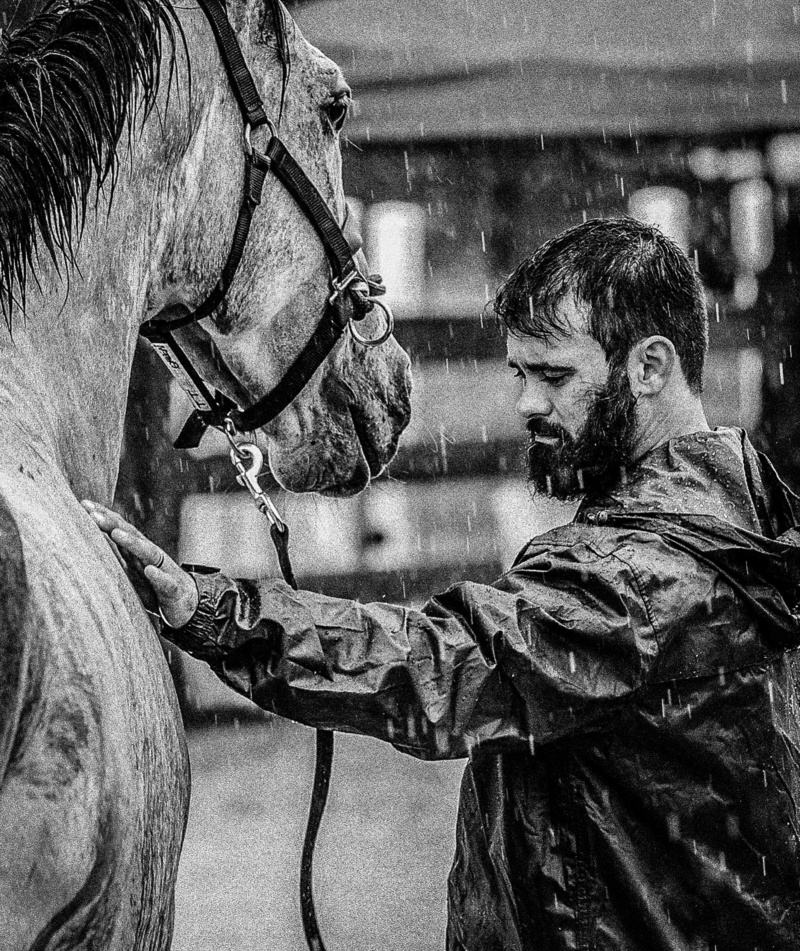
What does a typical program entail?
It’s a three-day process, which is a little misleading because one day is travel, which can be a big deal for many veterans. They arrive in Aiken and meet with the veteran liaison. They fill out some paperwork and get to know each other, and then they go to dinner together. We put them up in the hotel overnight. They have breakfast at the hotel in the morning, then travel out to Aiken Equine Rescue, and that’s where I step in. I give a two-hour lecture which has three components: the psychology of the horse and how a horse is in nature; then we talk about the off-the-track thoroughbreds and why we use them; and finally, we talk about what we’re going to do with the horses in the round pen. We take a break for lunch, and then we go down and play in the round pen with one of us running around like a horse, and they get to toss the rope and then practice the six exercises that we’ve discussed. Without the horse present, I can assess them, make sure they can follow directions, and make sure that they’re physically and mentally able, as well as emotionally ready.
Once I pair them with a horse, they meet the horse in the round pen to perform the exercises. Eventually, the veterans turn the horse loose, and it gallops around them. Through their body language, they learn to communicate with the horse and give the horse the opportunity to connect, or approach through an invitation. Finally, they have some bonding time with their horse outside of the round pen. Their actual time with the horse is quite short, but the impact is quite massive. After they’ve worked with the horses, we do a debrief. Each person gets to talk about what happened, and it’s sort of a free-flowing conversation. Then we take them to dinner at someone’s home. We have wonderful people in our community that offer up their homes, and they make us a homecooked meal that is very casual, relaxed, and buffet-style so the veteran attendees can continue their processing, sharing, and – usually – excitement. After another night at the hotel, they once again meet with the veteran liaison and then they are free to travel home.
When I first heard about the program I came up with 75 ways to make it longer, and all these things that attendees should be required to do, but the founder of SWH was adamant that this process works and it should not be changed. After seeing the results with veteran after veteran, I really believe that now, too. This is a very powerful, one-time impact that stands alone as a magical experience.
Do the veterans take anything home with them?
They get a gift bag when they arrive, which has a journal and some merchandise from SWH, as well as some gifts from people in the community. We also have the experience professionally photographed and videotape, and we share the photos with them a few weeks after each program. Shelly Schmidt has done a lot of our photography. Her photography will be at The HeART of the Horse, a conference celebrating the art of community and the equine spirit, held April 23-26 in Aiken. Her exhibit is called “Silent Witness,” and it’s very moving … even for me, and I’m there for every program! Shelly really captures the connection that we find so hard to put into words.
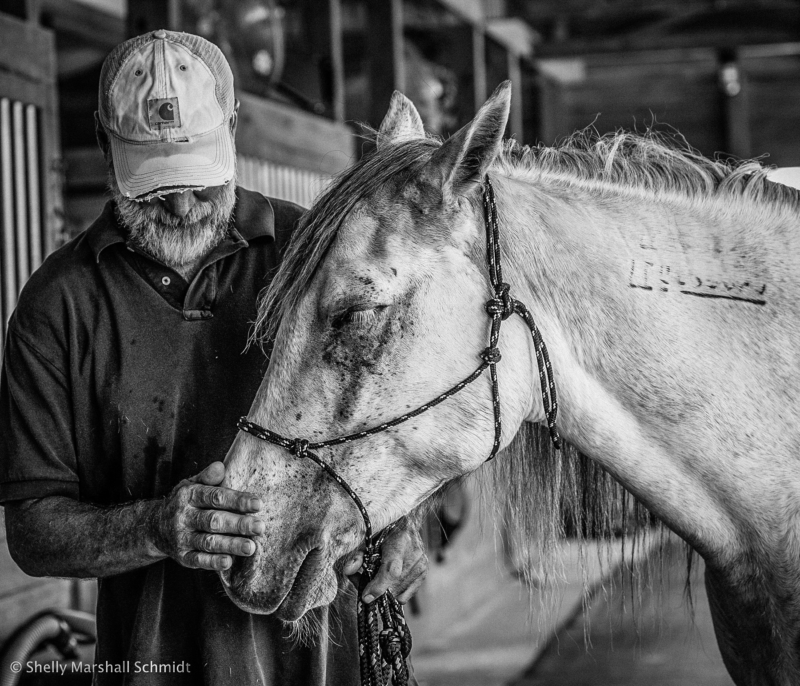
Most equestrians inherently understand the intangible healing power of horses. Is there a common defining moment that many program attendees allude to?
There is a very clear moment, and it usually happens in one of three places. For some, it’s when they turn the horse loose, and feel the power of that horse moving with energy around them. There is a moment when they kind of make eye contact, and it has proven to be very powerful one. The second point that proves to be powerful is when they invite the horse in. If they’ve made the right connection, the horse turns and walks to them. The moment when that horse goes from high-headed and not paying attention to lowering the head and walking towards them is another very powerful one. The third point would be for those who kind of weren’t really sure what just happened, and they have the opportunity to go spend some time with their horse while the next person does the exercises.
The words we most often hear are hope, trust, and connection. We’ve heard many statements such as, “When that horse was running around me, it was like every burden I’ve ever had was lifted off my body.” We know that there is something that takes place between the horse and human. We believe that for veterans in particular, having to use only body language and intention to connect with the horse can be very powerful. It is like a floodgate being opened, and they can’t believe what they feel from the horse. They disclose that they become more connected to their emotions through the process. Some who say they hadn’t been feeling anything for some time suddenly say that they feel compassion, and say they feel like a switch has been flipped on. Some say they were shut down or angry, and suddenly there is a middle ground and a range of emotions again. They laugh again! We think that somehow the program helps connect the brain back to an emotional state.
Some of the coolest feedback we get is from the therapists of the veterans that go through the program. They’ll ask what happened, and tell us that they’ve been working with a person for five years and the person hasn’t opened up at all, and suddenly the person pours out their emotions, cries, and shares their trauma after attending our program.
Can you share an anecdotal success story?
We had one situation in which we put a horse in with a veteran, and when he turned her loose she was lame. She had an abscess and we had missed it, so she was moving around looking like she had a broken leg. We were going to switch horses for him, but he said he wanted to work with that particular horse. We just let him work through the directive, and when he was done he asked why we had given him that particular horse. First, the horse’s name was Annalise, and he told us his wife’s name was Lisa Anne. Of course, we didn’t know that when we paired them, and that was meaningful to him. Second, he said it was the first time that he’d seen someone or something in distress, and he hadn’t wanted to extinguish it. He said he thought what he felt was compassion. He saw the horse struggling and all he wanted to do was spend the time with it, let it slow down, and let it know that he could help it. He said he couldn’t explain what a different feeling that was for him.
Now this gentleman is a part of our board, and he has become a huge advocate for us. He also works with veterans at The University of South Carolina, Aiken, helping them get back to college through the G.I. Bill.
We have heard that the military often breaks people down to build them back up with a different mental state. It sounds like what you do is unravel all of that.
I really think that’s exactly what we do. You go in as a young boy or girl, and you’re broken down and then built back up as a soldier. When you come out, you’re still a soldier, and the military does nothing to help you come back out with some human qualities. You’re never going to be a boy again. You’re never going to be a civilian. But our program provides this transition path so you can choose to connect back to your emotional self. However, it is something these veterans have to do for themselves. It’s not something they can be coached through or be made to do, and that’s why I call myself a facilitator. The program’s impact only goes as deep as the person allows it to go.
What would you like the one takeaway to be for our readers, whether they fit into one of these programs or not?
Anybody who loves a horse knows that horses have this amazing ability to give us a leg up in life, so I use the acronym LEG UP.
L: Look up! So many of us look down at our phones or at our feet. So look up. Get your chin up. You’re here on this planet, so be present!
E: Engage with your horse on any level, but take time to enjoy that part of it. Hack out a little bit! Have some fun!
G: Greet every creature that comes into your life with openness.
U: Understand that you have no idea where a horse is or a person is in their life, or what they are going through, or have been through. You have no idea of the struggles that they face!
P: Provide presence, and take the time that it takes. If you only have 5 minutes at the barn, go stand next to your horse and don’t ask much from him. It’s the same with people. Walk up beside a person from time to time, and just be present.
By doing all of the above, I think we give others and horses a leg up, and who couldn’t use a leg up in life?
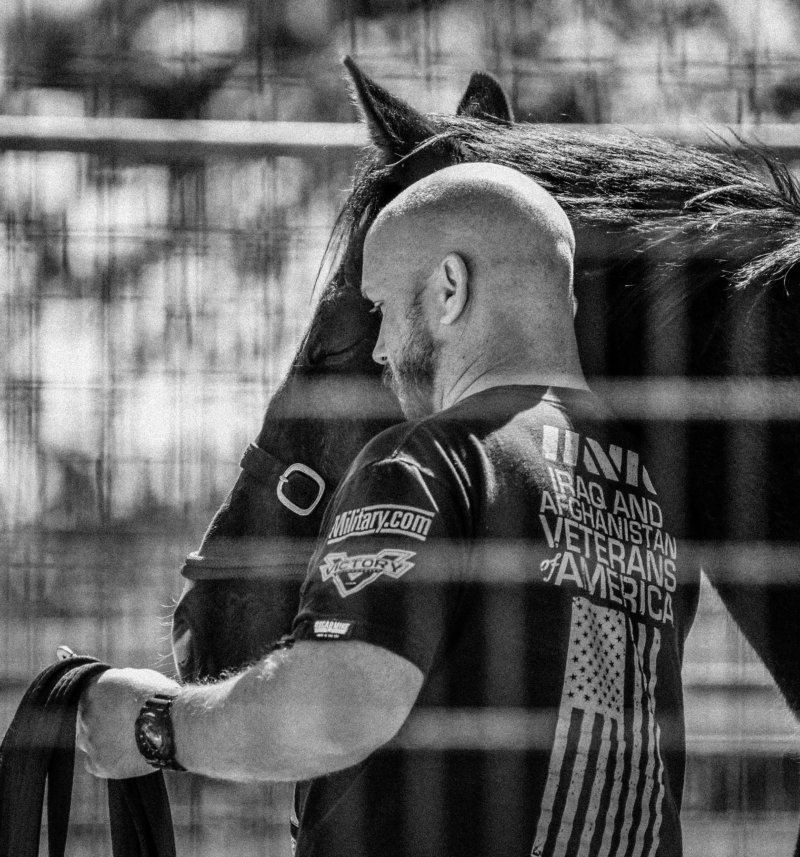
A COMPLIMENTARY IMAGE FROM “SILENT WITNESS”
By SHELLY SCHMIDT


